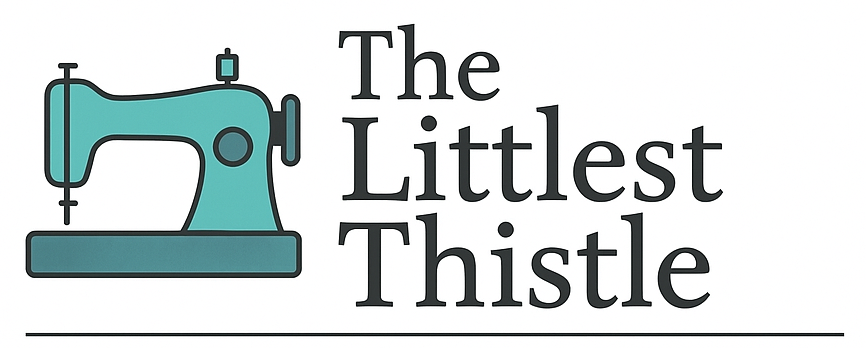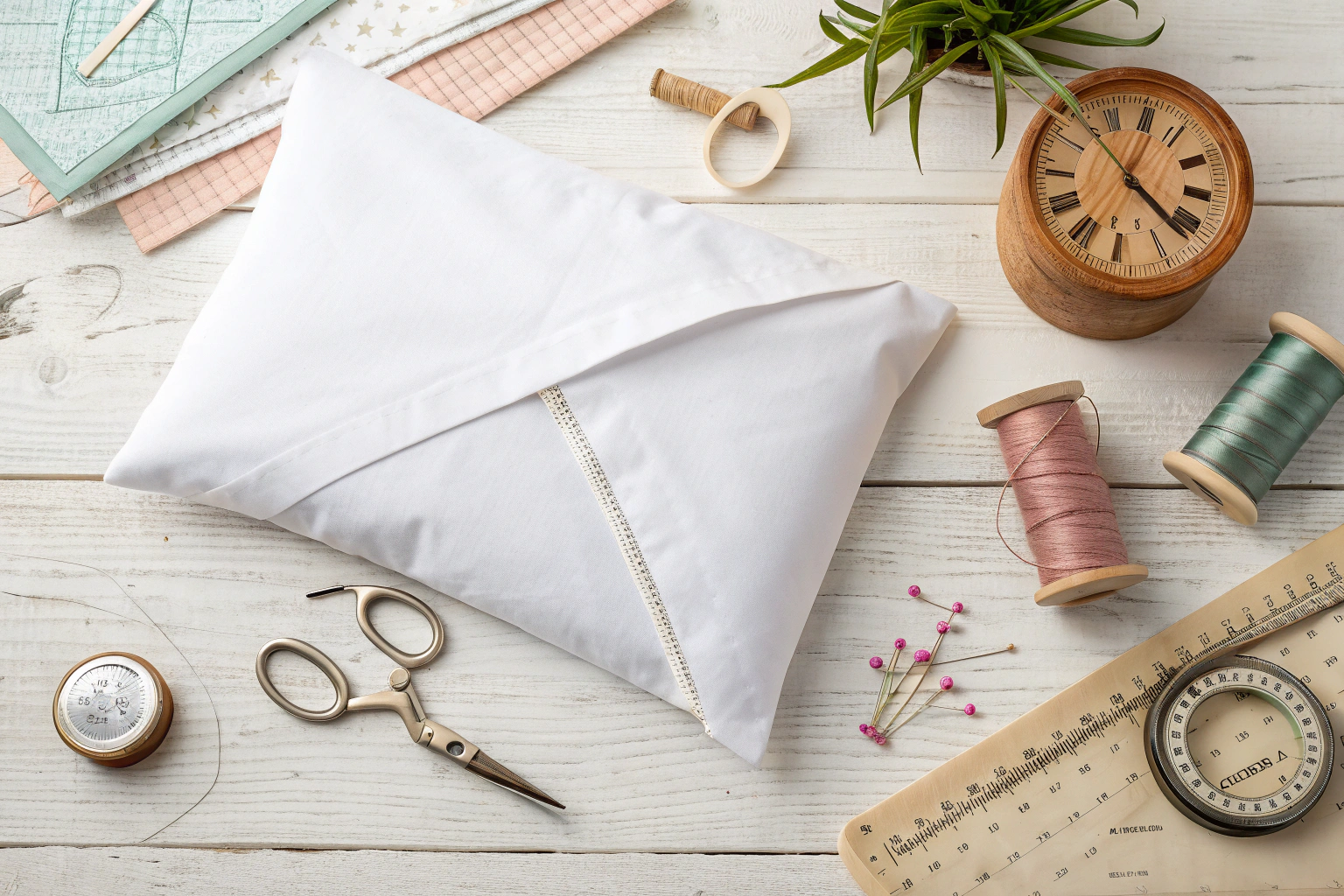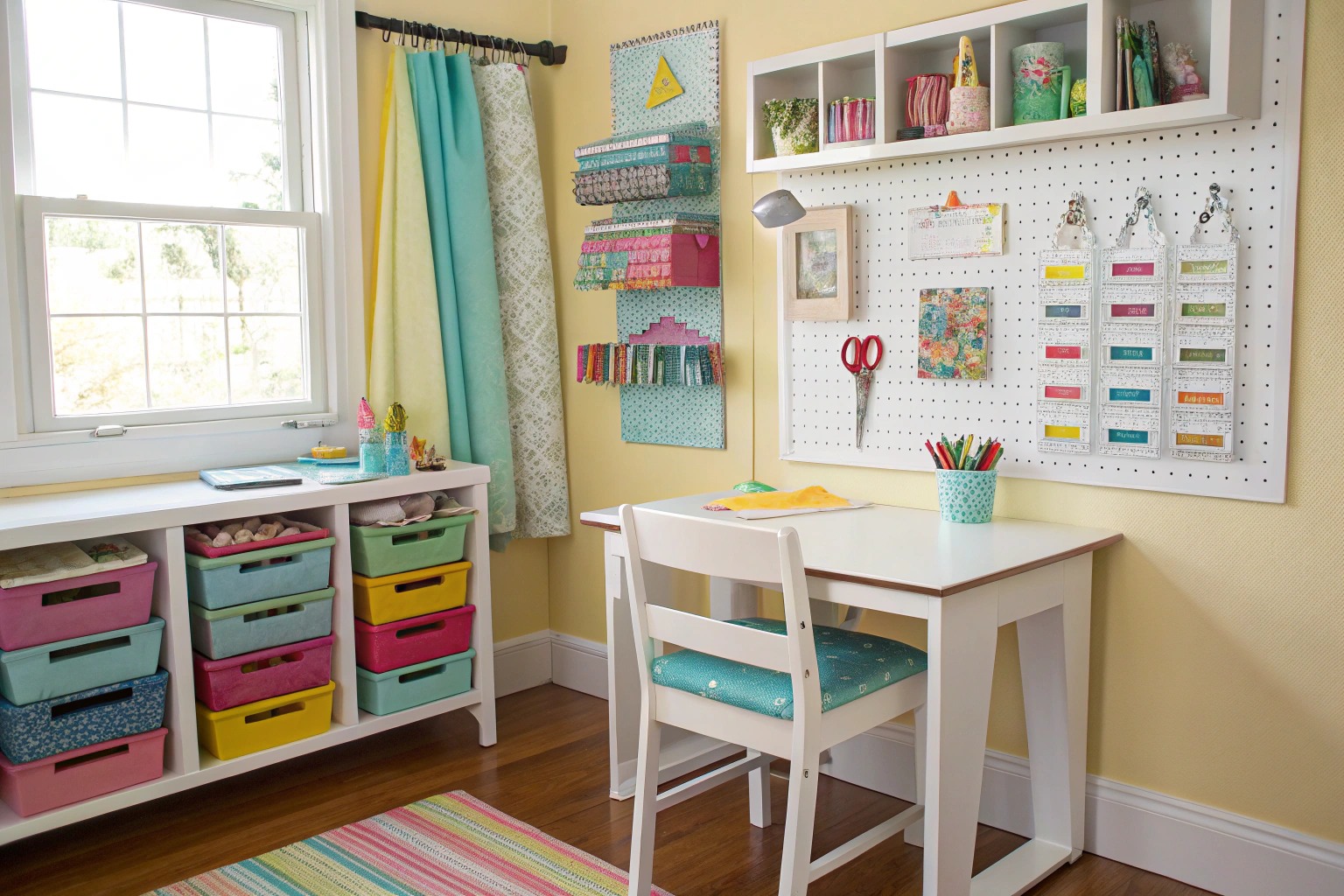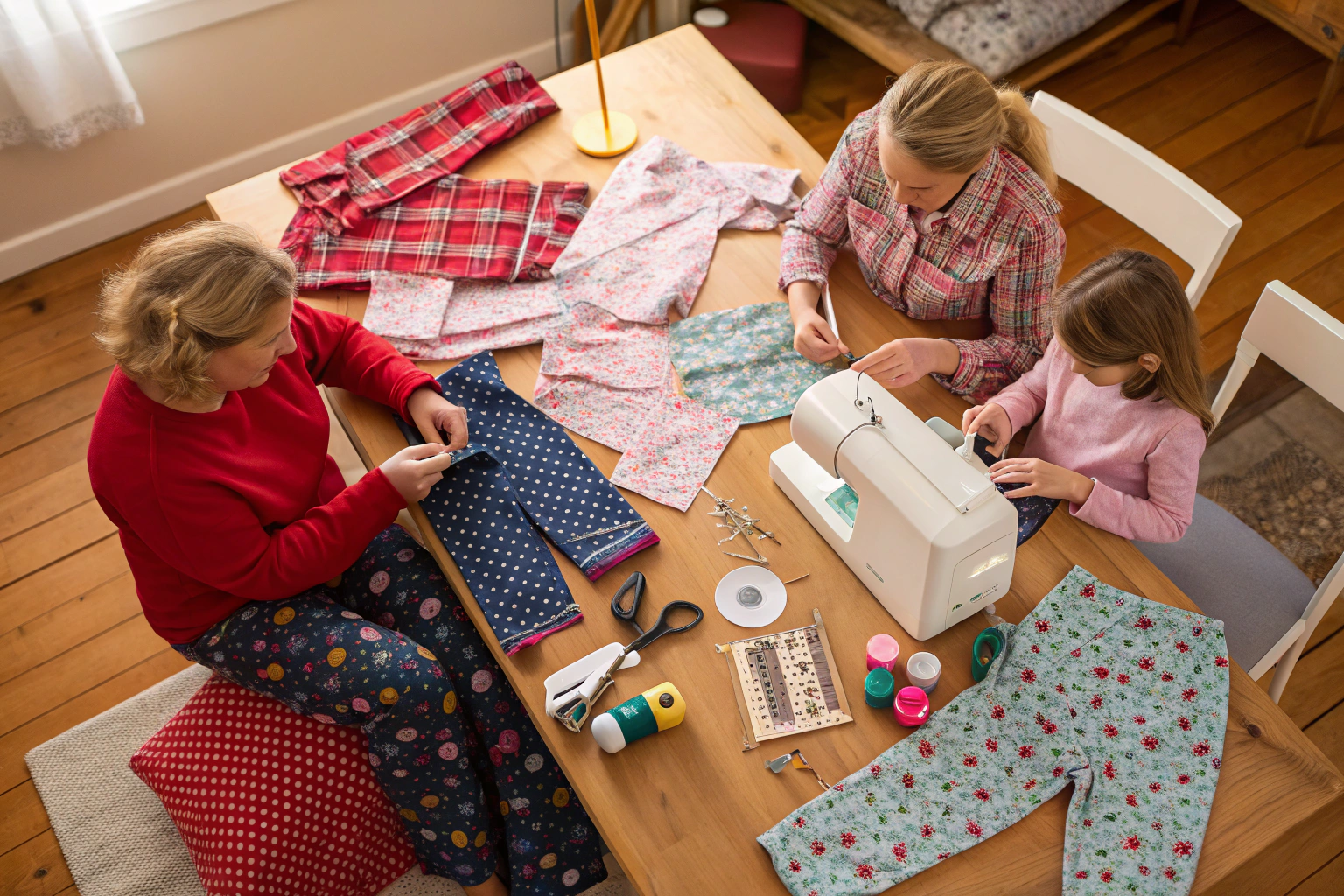Learning how to sew a pillowcase with flap, also known as an envelope closure, is a simple sewing project perfect for beginners. This design features an internal fabric flap that neatly tucks the pillow in, preventing it from sliding out. Unlike pillowcases with zippers or buttons, this method requires only straight stitches and clever folding, creating a clean, professional finish with minimal fuss and no uncomfortable hardware.
Key Benefits at a Glance
- Secure Fit: The internal flap keeps your pillow fully encased, ensuring it stays clean and doesn’t slip out during the night.
- Neater Appearance: An envelope closure provides a polished, seamless look for a tidy bed, with no pillow peeking out.
- Beginner-Friendly: This project requires no complicated hardware like zippers or buttons, making it fast and easy to complete with basic sewing skills.
- Enhanced Durability: With fewer stress points than a traditional open-ended case, these pillowcases hold up well to repeated washing and use.
- Full Customization: Easily create custom-sized pillowcases for any pillow and use your favorite fabrics to perfectly match your decor.
Purpose of this guide
This guide is for beginner sewers and anyone wanting to create custom, professional-looking bedding at home. It solves the common problem of pillows slipping out of standard cases by providing a simple, step-by-step solution for sewing an envelope closure. You will learn how to measure and cut fabric for any pillow size, master the folding technique to create the flap, and sew straight seams for a durable finish. We also cover common mistakes to avoid, ensuring your project is a success from the first try.
Introduction
Three years ago, I found myself constantly frustrated with my pillows sliding out of their cases during the night. No matter how carefully I tucked them in, I’d wake up to find bare pillows and bunched-up fabric at the foot of my bed. That’s when I discovered the magic of pillowcases with flaps – a simple design that would revolutionize my sleep quality and spark a passion for creating beautiful, functional bedding.
As someone with over fifteen years of experience in sewing and textile arts, I’ve made everything from intricate quilts to delicate embroidered linens. But it was this humble pillowcase design that truly captured my heart. What started as a solution to my own pillow problems quickly became my go-to project for gifts, guest rooms, and my own bedroom refresh projects. Over the years, I’ve refined this technique through countless iterations, teaching it to friends and family members who were equally amazed by the difference a simple flap could make.
The beauty of this project lies in its simplicity and effectiveness. Even as an experienced seamstress, I appreciate how this design combines beginner-friendly techniques with professional-looking results. I’ve watched novice sewers successfully complete their first pillowcase with flaps in just an afternoon, gaining confidence that carries over into more complex projects.
- Beginner-friendly project suitable for new sewers
- 1-2 hours total time required
- Basic skills needed: straight stitching and measuring
- Creates secure pillow fit that prevents slipping
- Perfect for gifts and personal use
Why choose a pillowcase with a flap
My journey with flap pillowcases began out of pure necessity. Like many people, I struggled with traditional open-end pillowcases that seemed designed to let pillows escape at the worst possible moments. I’d spend precious morning minutes hunting for pillows that had somehow migrated to the foot of the bed, or worse, onto the floor. The frustration was real, especially when hosting guests who would politely mention their “wandering pillows” at breakfast.
The flap design solved these problems immediately. The first night I used my newly sewn flap pillowcase, I slept soundly knowing my pillow was securely enclosed. When I woke up, everything was exactly where it should be – pillow snug in its case, bed looking neat and tidy. My partner, who tends to be a restless sleeper, was equally impressed by how the flap kept his pillow in place despite his nighttime movements.
“This method of making an envelope pillowcase protects both ends of your pillow with an inner flap at the open end. It is sometimes referred to as a pillowcase with a flap. I’ve seen these types of pillowcases used at hotels and like the extra coverage of the pillow insert. This is a perfect method for making special pillow covers for your guest rooms.”
— Create Whimsy, October 2025
What truly convinced me of this design’s superiority was the feedback from friends and family. Every guest who stayed in our spare room commented on how well their pillows stayed put. Several asked for the “secret” behind these special pillowcases, and many requested them as gifts for their own homes. The flap design has become my signature contribution to housewarming gifts and wedding presents.
“I love how the flap keeps your pillow from sliding out while you’re sleeping. In fact, the envelope flap keeps you from ever seeing the pillow insert itself at all. How handy when it isn’t very attractive—your pillow is completely enclosed in whatever pretty fabric you choose.”
— Wildish Acres, October 2025
| Feature | Flap Pillowcase | Traditional Pillowcase | Zippered Pillowcase |
|---|---|---|---|
| Pillow Security | Excellent – flap prevents slipping | Poor – pillows slide out | Excellent – fully enclosed |
| Ease of Use | Easy – simple envelope closure | Very easy – open end | Moderate – zipper operation |
| Durability | High – reinforced closure | Moderate – open end stress | High – but zipper can break |
| Cost | Low – basic materials | Lowest – minimal fabric | Higher – zipper required |
| Appearance | Clean, tailored look | Basic, functional | Professional finish |
Materials and tools you’ll need
After years of experimenting with different materials and tools, I’ve developed strong preferences based on what actually works in practice. My thread choice has evolved from whatever was cheapest to investing in quality polyester or cotton-wrapped polyester threads that withstand countless wash cycles without breaking down. I learned this lesson the hard way when several early pillowcases developed loose seams after just a few months of use.
For scissors, I always recommend investing in a good pair of fabric shears that you reserve exclusively for sewing. I made the mistake early on of using household scissors, which resulted in frayed edges and uneven cuts that affected the final appearance of my pillowcases. A sharp rotary cutter and cutting mat can also speed up the process significantly, especially when making multiple pillowcases.
Budget-conscious sewers shouldn’t despair – many of these tools can be found at discount stores or borrowed from fellow crafters. I often recommend checking thrift stores for gently used sewing machines and tools. My first iron was a garage sale find that served me well for several years before I upgraded to a steam iron with better temperature control.
- 1 yard fabric (44-45″ wide) for standard pillowcase
- Matching thread
- Fabric scissors
- Measuring tape
- Straight pins
- Sewing machine
- Iron and ironing board
- Seam ripper (for corrections)
Fabric selection guide
My fabric journey has been one of trial and error, with some memorable mistakes along the way. Early in my sewing adventures, I fell in love with a beautiful but loosely woven cotton that looked perfect in the store. After the first wash, it had shrunk unevenly and developed pulls throughout the fabric. This expensive lesson taught me to always check fabric content and weave quality before purchasing.
Through extensive testing with different materials, I’ve found that 100% cotton with a thread count between 200-400 provides the best balance of durability, comfort, and ease of sewing. Cotton percale, with its crisp hand and excellent breathability, has become my go-to choice for everyday pillowcases. For special occasions or gifts, I occasionally splurge on cotton sateen, which provides a luxurious feel despite being more challenging to work with due to its slippery nature.
One fabric disaster I’ll never forget involved a gorgeous linen that seemed perfect for summer pillowcases. While the finished products were beautiful, the wrinkle factor was so extreme that they looked perpetually rumpled, even fresh from the iron. I learned to save linen for more casual applications where the lived-in look is part of the charm.
| Fabric Type | Pros | Cons | Best For |
|---|---|---|---|
| 100% Cotton | Breathable, durable, easy care | Can wrinkle | Everyday use, all seasons |
| Cotton Percale | Crisp, cool, long-lasting | May feel stiff initially | Hot sleepers, summer |
| Cotton Sateen | Smooth, lustrous finish | Less breathable | Luxury feel, special occasions |
| Linen | Natural, temperature regulating | Wrinkles easily, expensive | Summer, rustic decor |
| Flannel | Soft, warm, cozy | Pills over time | Winter, children’s rooms |
Preparing your fabric
Pre-washing fabric is a step I never skip, no matter how eager I am to start sewing. I learned this lesson after completing a beautiful set of pillowcases in a rich burgundy cotton, only to have them shrink to child-size proportions after their first trip through the washing machine. Now I always wash and dry fabric using the same settings I plan to use for the finished pillowcases.
My ironing technique has evolved to save time while ensuring professional results. I iron fabric while it’s still slightly damp from the dryer, which requires less steam and creates sharper creases. For stubborn wrinkles, I use a spray bottle with distilled water rather than relying solely on the iron’s steam function, which can sometimes leave mineral deposits on delicate fabrics.
Checking fabric grain might seem like an advanced step, but it’s crucial for achieving a professional finish. I learned to identify when fabric has been pulled off-grain during manufacturing or storage by looking for diagonal wrinkles that don’t press out easily. Taking a few minutes to straighten the grain prevents twisted seams and ensures the finished pillowcase hangs properly.
- Pre-wash fabric in warm water with regular detergent
- Dry according to fabric care instructions
- Iron fabric while slightly damp for best results
- Check fabric grain and straighten if needed
- Lay fabric flat on cutting surface
- Mark measurements with fabric chalk or washable marker
Step by step sewing instructions
Over the years, I’ve refined this pillowcase-making process into a streamlined system that produces consistent, professional results every time. Even though I could probably sew these with my eyes closed at this point, I still follow these exact steps to ensure I don’t skip any details that contribute to the final quality. The beauty of having a systematic approach is that it prevents the small mistakes that can accumulate into bigger problems during construction.
This process has evolved through making dozens of pillowcases for my own home, gifts for friends and family, and even a few custom orders for local boutiques. Each iteration taught me something new about efficiency without sacrificing quality. What you’ll find here is the distilled wisdom of countless hours at the sewing machine, perfecting a technique that balances speed with precision.
For a step-by-step video tutorial, refer to the visual guide from a seasoned home sewing instructor.
Measuring and cutting your fabric pieces
Precision at the measuring and cutting stage sets the foundation for everything that follows. I’ve learned that taking extra time here prevents frustration later when pieces don’t align properly or the finished pillowcase doesn’t fit correctly. My preferred method involves using a large cutting mat with grid lines, which helps ensure perfectly square cuts and accurate measurements.
Through extensive experience making pillowcases for various bed sizes, I’ve developed these measurements that provide the perfect fit without excess bulk or insufficient coverage. The key is allowing enough seam allowance while maintaining proportions that work well with standard pillow dimensions. I always add an extra half-inch to my calculations to account for the thickness of different pillow fills and personal preference for fit.
If you need measurements and a quick-sew technique, check the fabric calculator at Rambling Renovators, which shows how to adapt the process for any pillow size.
| Pillow Size | Main Body Piece | Flap Piece |
|---|---|---|
| Standard (20″ x 26″) | 21″ x 33″ | 21″ x 10″ |
| Queen (20″ x 30″) | 21″ x 37″ | 21″ x 10″ |
| King (20″ x 36″) | 21″ x 43″ | 21″ x 10″ |
Creating the inner flap
The flap construction is where this pillowcase design truly shines, and I’ve developed a foolproof technique for achieving perfectly straight, professional-looking edges. My method involves careful pressing at each stage, which might seem excessive but creates the sharp, clean lines that distinguish handmade quality from amateur attempts.
One technique I discovered after making dozens of flap pillowcases involves using a pressing cloth when working with cotton sateen or other delicate fabrics. This prevents shine and ensures the fabric maintains its original texture. I also learned to adjust my iron temperature based on fabric content – a lesson learned after accidentally creating permanent creases in a beautiful silk blend.
The topstitching along the flap edge serves both functional and aesthetic purposes. It reinforces the fold and creates a professional finish that rivals store-bought pillowcases. I use a slightly longer stitch length for this topstitching, which reduces bulk and creates a more attractive appearance.
- Fold flap piece in half lengthwise, wrong sides together
- Press fold with iron to create sharp crease
- Fold raw edges under 1/4″ and press
- Topstitch along folded edge 1/8″ from fold
- Press entire flap piece flat
Attaching the flap to the main pillowcase
Proper alignment of the flap is crucial for both function and appearance. I developed my current pinning technique after struggling with misaligned flaps in my early attempts, which resulted in pillowcases that looked homemade in the worst way. The key is using plenty of pins and taking time to check alignment from multiple angles before committing to stitching.
My preferred method involves basting the flap in place before the final stitching. This extra step might seem unnecessary, but it allows for adjustments and ensures the flap stays perfectly positioned during the more aggressive handling of machine stitching. I use a contrasting thread for basting so it’s easy to see and remove later.
The 6-inch placement from the end creates the ideal balance between security and ease of use. I experimented with various distances and found that closer placement makes pillow insertion difficult, while farther placement reduces the flap’s effectiveness in keeping pillows secure.
- Place main body piece right side up
- Position flap piece 6″ from one short end, right sides together
- Pin flap securely along raw edge
- Baste flap in place 1/8″ from edge
- Check alignment before final stitching
- Stitch with 1/2″ seam allowance
Sewing the side seams
French seams are my preferred method for finishing pillowcase seams, despite requiring additional time and steps. The investment pays off in durability and appearance – these seams can withstand years of washing without fraying or coming apart. I transitioned to French seams after noticing that my earlier pillowcases with basic seams showed wear along the edges after just a few months of regular use.
The technique requires precision, but the results justify the effort. French seams completely encase raw edges, preventing fraying and creating a clean interior that looks as professional as the exterior. This is particularly important for pillowcases since the interior is visible when changing linens.
Temperature control on your iron becomes critical during this stage. Too hot, and you risk creating permanent creases in the wrong places. Too cool, and the seams won’t press flat enough for the second stitching line. I keep my iron on the cotton setting for most fabrics and adjust as needed.
- Fold pillowcase in half, wrong sides together
- Pin side and bottom edges
- Stitch with 1/4″ seam allowance
- Trim seam to 1/8″
- Turn pillowcase inside out
- Press seams flat
- Stitch again with 1/4″ seam allowance to enclose raw edges
Finishing touches
The final pressing stage transforms a good pillowcase into a great one. I press all seams carefully, paying particular attention to the corners where multiple layers create bulk. Using a pressing cloth prevents shine on delicate fabrics and ensures consistent results across different material types.
Corner finishing requires patience but makes a dramatic difference in the final appearance. I use a blunt tool like a chopstick or point turner to push out corners completely without creating holes in the fabric. This attention to detail separates handmade quality from mass-produced alternatives.
For gift pillowcases, I often add personal touches like decorative topstitching in contrasting thread colors or small embroidered motifs. These elements should be planned from the beginning of the project to ensure proper placement and execution. Simple additions like these transform a practical item into a treasured keepsake.
- Press all seams flat for professional appearance
- Trim any loose threads
- Turn pillowcase right side out
- Push out corners with blunt tool
- Press opening edge for crisp finish
- Optional: Add decorative topstitching or embroidery
How to use a pillowcase with a flap
Using a flap pillowcase becomes second nature once you understand the simple technique, but I remember being slightly confused the first time I tried to put one on a pillow. The process is actually easier than traditional pillowcases once you get the hang of it, and the results are so much more satisfying.
My personal routine for changing these pillowcases has become streamlined over the years. I start by inserting the pillow into the main opening, pushing it all the way to the closed end. Then I fold the flap over the pillow end, creating a secure envelope that completely encloses the pillow. The beauty of this design is that once the pillow is in place, it stays put through even the most restless night’s sleep.
Family members who initially questioned why I was “complicating” something as simple as a pillowcase quickly became converts after experiencing how well these work. My partner, who used to wake up searching for escaped pillows, now specifically requests the flap-style cases for his side of the bed. Even guests comment on how their pillows stayed perfectly in place throughout their visit.
How to fold a pillowcase with a flap
Proper folding technique for flap pillowcases requires a slightly different approach than traditional cases, but the result is actually neater and more compact. I developed my folding method to maintain the flap’s shape and minimize wrinkles that could affect the professional appearance when the pillowcase is put back into use.
My linen closet organization system keeps different sets together while making it easy to identify the flap-style cases at a glance. I fold them so the flap is visible on the outside, which serves as both identification and protection for the more structured opening. This method also prevents the flap from getting crushed under the weight of other linens.
Storage considerations become important when you have multiple sets of these special pillowcases. I learned to avoid overpacking them in storage containers, as the flap can develop permanent creases that are difficult to press out. Instead, I give them slightly more space than traditional pillowcases require, which pays off in their continued crisp appearance.
Troubleshooting common issues
Throughout my years of making flap pillowcases and teaching this technique to others, I’ve encountered virtually every problem that can arise during construction. Each challenge taught me something valuable about prevention and correction techniques that I now share with fellow sewers who find themselves facing similar issues.
One particularly memorable project involved a gorgeous fabric that seemed perfect until I started sewing. The weave was looser than I realized, causing puckering along every seam despite my careful technique. This taught me the importance of testing stitch settings on fabric scraps before beginning the actual project. I learned to adjust my machine’s tension and use a slightly shorter stitch length for loosely woven fabrics.
Misaligned flaps plagued my early attempts until I developed the comprehensive pinning and basting system I use today. The extra time spent on proper alignment prevents the frustration of having to rip out and re-sew seams, ultimately saving time and preserving fabric integrity. I now consider thorough preparation an investment rather than a delay.
- Puckered seams: Check thread tension and use appropriate needle size
- Uneven flap alignment: Use more pins and baste before final stitching
- Fabric fraying: Use pinking shears or serger on raw edges
- Crooked stitching: Use seam guide or mark stitching line
- Bulky seams: Grade seam allowances or use French seams
Variations and customization ideas
Over the years, I’ve created numerous variations of the basic flap pillowcase design, each tailored to specific needs or aesthetic preferences. My seasonal pillowcase collection includes festive holiday prints, fresh spring florals, and cozy autumn plaids that help transform the bedroom’s atmosphere throughout the year. These themed sets have become a favorite way to celebrate changing seasons without major decorating investments.
One of my most successful custom projects was a set of pillowcases for a friend’s teenage daughter, featuring her favorite band’s colors with carefully placed decorative elements. The challenge was incorporating her style preferences while maintaining the sophisticated construction techniques that ensure longevity. The result was so popular among her friends that I received several additional requests for similar customizations.
Children’s themed pillowcases present unique opportunities for creativity while requiring extra attention to durability. I’ve learned to reinforce areas that receive extra wear and to choose fabrics that can withstand frequent washing. Appliqué work and decorative stitching add personality while serving functional purposes like identifying individual pillowcases in shared bedrooms.
- Add contrasting fabric trim along flap edge
- Embroider monograms or decorative motifs
- Use seasonal prints for holiday themes
- Create matching sets with coordinating fabrics
- Add piping for professional pillow sham look
- Use vintage buttons for decorative closure
Caring for your handmade pillowcase
Proper care techniques can extend the life of handmade pillowcases significantly, and I’ve developed specific methods for different fabric types based on years of testing what actually works in practice. My oldest handmade pillowcases, now over five years old, still look fresh and maintain their shape thanks to consistent care routines that protect the fabric while ensuring thorough cleaning.
Cotton pillowcases respond beautifully to gentle washing in cool to warm water, followed by air drying when possible. I learned that high heat can cause gradual fabric degradation, leading to thinning and eventual tearing along stress points. Line drying also helps maintain the crisp hand of cotton fabrics, though I do use the dryer on low heat when weather doesn’t permit air drying.
Delicate fabrics like silk or fine cotton sateen require more careful handling, including turning inside out before washing to protect decorative elements and surface texture. I use mesh laundry bags for these special pieces and always opt for gentle cycles with appropriate water temperatures. The extra care required is justified by the extended lifespan and continued beauty of these investment pieces.
- DO wash in cool to warm water to prevent shrinkage
- DO turn inside out to protect decorative elements
- DON’T use bleach on colored fabrics
- DO air dry when possible to extend fabric life
- DON’T over-dry in machine to prevent stiffness
- DO iron while slightly damp for best results
Questions
How much fabric do I need for different pillow sizes?
For standard pillowcases, one yard of 44-45 inch wide fabric provides enough material with some leftover for testing stitches. Queen size requires about 1.25 yards, while king size needs approximately 1.5 yards. I always recommend buying slightly more than calculated to account for fabric shrinkage and potential mistakes.
Can I make flap pillowcases without a sewing machine?
While possible to hand-sew, machine stitching provides the durability needed for items that will be washed frequently. If hand-sewing, use backstitch for seams and consider reinforcing stress points with additional stitching. The process will take considerably longer but can produce acceptable results for decorative or occasional-use pillowcases.
What’s the best stitch length for pillowcase construction?
I use a 2.5mm stitch length for most construction seams, which provides good strength without creating excessive bulk. For topstitching and decorative elements, I increase to 3mm for better visibility and appearance. Very lightweight fabrics may require shorter stitches to prevent puckering.
How do I adjust the flap size for different pillow thicknesses?
The standard 10-inch flap works well for most pillow types, but very thick or thin pillows may require adjustments. For thick down pillows, increase flap length to 12 inches. For thin foam pillows, 8 inches may be sufficient. Test fit before final cutting to ensure proper coverage.
Why do my French seams look bulky?
Bulky French seams usually result from inadequate trimming after the first stitching or using too wide a seam allowance. Trim the first seam to exactly 1/8 inch and ensure your second stitching line fully encases the raw edges without creating excessive bulk. Press carefully between steps for best results.
Frequently Asked Questions
How do I sew an elastic waistband for beginners?
Start by learning how to measure waist for men accurately to cut the elastic 2-4 inches shorter than the measurement for a snug fit, using beginner sewing techniques. Fold the fabric to create a casing, insert the elastic with a safety pin, and sew the ends together before closing the opening with straight stitches. This handmade project is perfect for modifications like adding drawstrings for extra comfort.
Common methods include sewing a casing and threading elastic through it, or directly stitching elastic to the fabric for a gathered look, both starting with instructions on how to measure waist men to ensure proper sizing. For advanced sewing techniques, try exposed elastic or topstitched versions for a professional finishing touch. These approaches work well for various craft projects, from pants to skirts, allowing for easy handmade modifications.
To avoid twisting, first understand how to measure waist for men precisely and cut elastic accordingly, then secure it with pins or stitches at intervals while inserting into the casing. Use wide elastic for better stability and sew the ends flat before closing, incorporating beginner sewing techniques for a smooth finish. This tip enhances your handmade project, preventing common issues in waistband construction.
When following instructions on how to measure waist men, cut the elastic 2-4 inches shorter for light stretch or up to 6 inches for a tighter fit, depending on the fabric and desired comfort. This ensures the waistband gathers nicely without being too restrictive, a key step in sewing techniques for beginners. Adjust based on your project type for optimal handmade results.
After learning how to measure waist for men and inserting the elastic, stretch the waistband evenly and sew parallel lines along the top and bottom edges using a zigzag stitch for flexibility. This finishing technique prevents rolling and adds a polished look to your craft project. It’s ideal for modifications in handmade garments like joggers or shorts.




